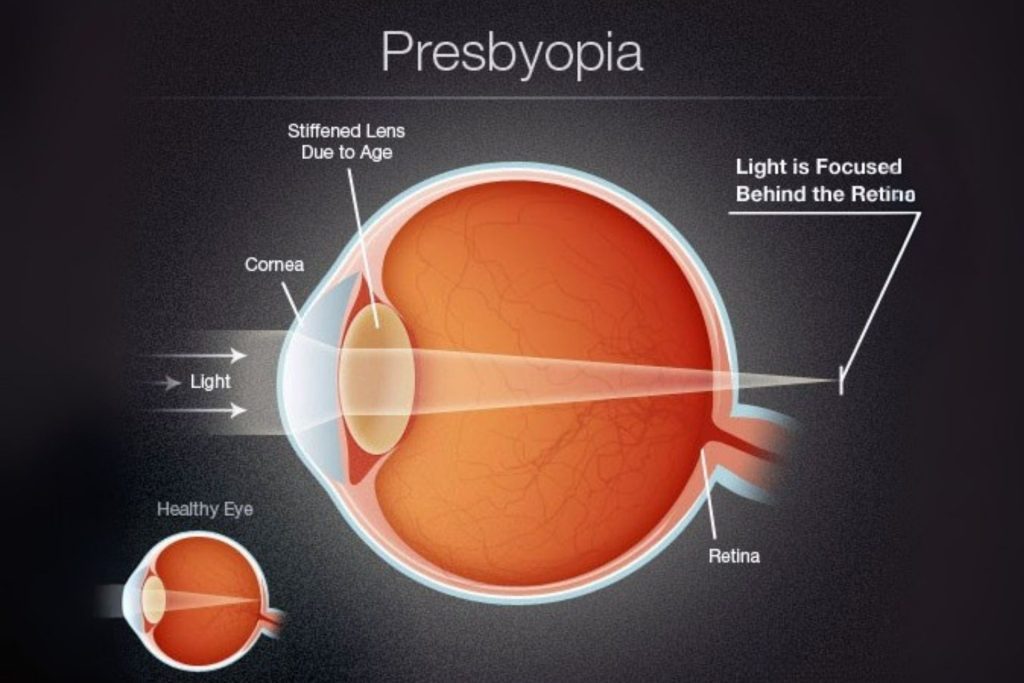![]()
Imagine: You turn 40. Suddenly reading up close is a challenge. A menu in a dark restaurant, instructions on a medicine bottle, and even your kid’s homework become difficult to read. You find yourself adjusting your font size and relying on your phone’s flashlight to help in dimly lit restaurants.
You are experiencing presbyopia. Let’s take a closer look (bad joke).
What is presbyopia?
Here’s the definition provided by the National Library of Medicine:
“Presbyopia occurs when the physiologically normal age-related reduction in the eye’s focusing range reaches a point, when optimally corrected for distance vision, that the clarity of vision at near is insufficient to satisfy an individual’s requirements.”
Presbyopia affects over a billion people. At least 50% of those over 50 are not treated due to a lack of awareness and access to treatments. Even in developed countries, 34% of the population remains untreated.
Essentially, your near vision is affected when the eye is unable to focus past a certain point because of structural changes in the crystalline lens. Though you do not notice changes in your vision until your 40s, the changes in the lens begin in the first decade of life. Presbyopia is not a sign of cataracts or a medical problem, but those who have systemic conditions like diabetes may have an earlier onset.
What is the cause of presbyopia?
Presbyopia is a condition caused by hardening of the lens inside the eye. The lens is responsible for approximately 30–35% of the eye’s refractive power.
Changes in the ocular lens can be detected in the eyes of patients in their twenties. The lens is located inside the eye, just behind the colored part of the eye called the iris. Its job is to focus light onto the retina. Your lens becomes less flexible and cannot change shape to focus on things up close.

Changes in the lens capsule’s elasticity, interior lens elasticity, and changes in the material properties between the lens capsule, fiber cell cortex, and fiber cell nucleus have all been observed, which alter the lens mechanics.
What are the symptoms of presbyopia?
Blurred vision at a normal reading distance is the main symptom. When presbyopia strikes, you’ll find yourself holding objects further away to see them better.
Another one symptom is difficulty focusing from near to far. For example, if you look at your phone followed by your TV, your TV may look blurry until your eyes adjust. Other common symptoms include eye strain, eye fatigue, and headaches.
Is everyone affected by presbyopia?
Yes. It happens to each one of us whether we have always worn glasses or have never worn glasses. It also occurs in those who had Lasik surgery. Those who have minor eyeglass prescriptions for distance may be able to take off their glasses and see up close, but when they have their distance glasses on, they will still be affected by presbyopia.
There is no way to stop presbyopia, and unfortunately, the condition will gradually worsen over time. Symptoms are typically noticed around or after the age of 40 with a complete loss of accommodation around 50–55 years.
How can presbyopia be corrected?
In the early stages, you can avoid glasses by holding your reading materials further away, increasing the font size on your phone or using brighter lights on your reading materials. But inevitably, you will need some type of vision correction.
The most common solution is over-the-counter reading glasses or “cheaters.” If you are looking for a more customized solution, eyeglasses and/or contact lenses are better options. Several eye drops are available but do come with limitations. If you are looking for a more permanent solution, refractive lens exchange is an alternative option.
Eyeglasses—the simple fix
Eyeglasses can be ordered in several different options for presbyopia. Single vision lenses are made for one distance, usually reading or computer.
“Computer lenses” are a type of multifocal lens. Sometimes referred to as occupational lenses and are perfect for those who use a multi-monitor setup. This type of lens allows you to see both the desktop and laptop distance through the same lens versus a single-vision lens that limits you to one distance.
Bifocal and trifocal lenses are also available. Both lens types have a delineated segment in the bottom of the lens. The half-moon addition allows the eyeglass wearer to read, while the top provides the distance correction. While these lenses have lost their popularity, they are still available for those who are unsuccessful with a progressive addition lens (PAL).
PALs are the most popular solution for those with presbyopia. The technology allows you to gradually shift your eyes through different powers. Distance correction is located at the top of the lenses. As you go down the lenses, the power builds to accommodate intermediate vision, and finally, near vision.
Click here for The Essential Guide to Prescription Lenses
Contact lenses—another option, or two
Contact lens options for presbyopia include either a monovision or a multifocal fit.
- Monovision means that one eye is fit for seeing distance and the other eye is fit for reading.
- A multifocal fit means both eyes have a lens that sees distance, intermediate, and near.
There are both positives and negatives for each fitting technique. Your eye doctor will choose based on your prescription, occupation, hobbies, and lifestyle. Sometimes, you may need to try both options to see what works best for you.
Refractive lens exchange—the permanent solution
A refractive lens exchange is a surgery similar to cataract surgery but performed in those who do not have cataracts. If you are a presbyope, LASIK will not work for you because it is designed to correct only distance vision, so you will still need reading glasses.
A refractive lens exchange surgery will correct both your distance and reading. A surgeon will remove your crystalline lens and replace it with a multifocal lens. This lens will work for the remainder of your life, and you will never develop cataracts and are unlikely to need glasses.
Eye drops—an emerging approach
A couple of prescription-only eye drops for presbyopia have been approved by the FDA in the last two years. The drops do have some limitations. They work for a certain number of hours, may have side effects, are best for a limited range of prescriptions, and are not covered by insurance. We expect for some eye drop therapies in the coming years which are likely to work better than the existing options.
Though presbyopia is a pain, there are many new options. With millennials starting to reach the onset of presbyopia, we expect for treatment technology to expand greatly in the new future.


